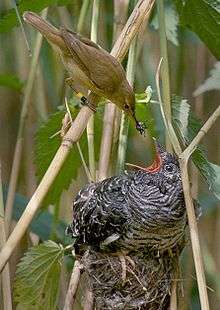Fixed action pattern
The term fixed action pattern (FAP), or modal action pattern, is sometimes used in ethology to denote an instinctive behavioral sequence that is relatively invariant within the species and almost inevitably runs to completion.[1]
Fixed action patterns, or similar behaviour sequences, are produced by a neural network known as the innate releasing mechanism in response to an external sensory stimulus known as a sign stimulus or releaser. A fixed action pattern is one of the few types of behaviors which was thought to be "hard-wired" and instinctive.
Terminology
The term "sign stimulus", or "releaser", is used to denote a simple feature of a complex stimulus that can elicit a FAP. For example, the red belly of a male stickleback elicits a head-down, attack behaviour in other male sticklebacks. This same response can be elicited by artificial models or objects that contain the sign stimulus of red, for example, a red coloured card.
The terms "sign stimulus" and "releaser" are sometimes used interchangeably; however, they have different meanings. The term "sign stimulus" is used to denote a feature of an animal's environment that elicits a particular response. The term "releaser" is used for a stimulus that has evolved to facilitate communication between conspecifics (animals of the same species).[2]
Examples

Male stickleback behaviour
Another example of fixed action patterns is the courtship and aggression behaviour of the male three-spined stickleback during the mating season, described in a series of studies by Niko Tinbergen. During spring, male sticklebacks change colour, establish a territory and build a nest. They attack male sticklebacks that enter their territory, but court females and entice them to enter the nest to lay eggs. Tinbergen used crude models of sticklebacks to investigate which features of male and female sticklebacks elicited attack and courtship behaviour from male sticklebacks. Tinbergen's main findings were that male sticklebacks responded in a relatively invariant way and attacked a model with a red belly, but in contrast, courted a model with a swollen belly.
Egg-retrieval behaviour
Another example of a behaviour that has been described as a FAP is the egg-retrieval behavior of the graylag goose, reported in classic studies by Niko Tinbergen and Konrad Lorenz. Like many ground-nesting birds, if an egg becomes displaced from the nest, the greylag rolls it back to the nest with its beak. The sight of the displaced egg is the sign stimulus and elicits the egg-retrieval behaviour. If the egg is removed from the goose during the performance of egg-rolling, the bird often continues with the behavior, pulling its head back as if an imaginary egg is still being maneuvered by the underside of its beak.[3] The greylag will also attempt to retrieve other egg-shaped objects, such as a golf ball, door knob, or even a model egg too large to have possibly been laid by the goose itself (i.e. a supernormal stimulus).[4]
Others
Other examples include:
- Some mating dances, commonly carried out by birds, are examples of fixed action patterns. In these cases, the sign stimulus is typically the presence of the opposite sex.
- Kelp gull chicks are stimulated by a red spot on the mother's beak to peck at the spot, which induces regurgitation.
- Some moths instantly fold their wings and drop to the ground if they encounter ultrasonic signals such as those produced by bats; see ultrasound avoidance.
- Mayflies drop their eggs when they encounter a certain pattern of light polarization which indicates they are over water.
- Some lizards and snakes exhibit strike-induced chemosensory searching behavior as a means of relocating bitten and envenomated prey by scent-trailing.[5][6][7]
Significance
FAPs, or inflexible behaviour patterns, are significant in animal behavior because they represent the simplest type of behavior in which a particular stimulus nearly always results in an invariable behavioral response. FAPs have been said to be "hard-wired". They are unusual in that they are relatively un-influenced by the environment, once the behaviour has been elicited.
The existence of FAPs is rather unusual in that a fixed response can lead to maladaptive results, whereas flexible behaviors are generally more likely to be adaptive by increasing fitness. Because of this, most behaviors which are both FAPs and occur in more complex animals are usually essential to the animal's fitness, or in which speed (i.e. an absence of learning) is a factor. For instance, the greylag goose's egg rolling behavior is so essential to the survival of its chicks that the fitness of the parent bird is increased by the behavior being relatively invariant. A stickleback will attack any male fish who enters his territory while the female is sexually receptive, reacting to their red colour, while the female stickleback triggers behavior in the male resulting in the fertilization of her eggs.[8] Relatively invariant behaviors are also predictable, which can lead to their exploitation by humans or other animals.
Exploitation

Some species have evolved to exploit the FAPs of other species by mimicry of their sign stimuli. Replicating the releaser required to trigger a FAP is known as code-breaking. A well-known example of this is brood parasitism, where one species will lay its eggs in the nest of another species, which will then parent its young. A young North American cowbird, for example, provides a supernormal stimulus to its foster parent, which will cause it to forage rapidly to satisfy the larger bird's demands.[9] A nestling will provide higher levels of stimulus with noisier, more energetic behavior, communicating its urgent need for food. Parents in this situation have to work harder to provide food, otherwise their own offspring are likely to die of starvation.
References
- ↑ Campbell, N. A. (1996). "Chapter 50". Biology (4 ed.). Benjamin Cummings, New York. ISBN 0-8053-1957-3.
- ↑ Kenyon, P. "Ethological Experiments". University of Plymouth. Retrieved August 1, 2014.
- ↑ "Video of grelag goose performing FAP".
- ↑ Tinbergen, N. (1951). The Study of Instinct. Oxford University Press, New York.
- ↑ Cooper, W.E. (2003). "Foraging mode and evolution of strike-induced chemosensory searching in lizards". Journal of Chemical Ecology. 29 (4): 1013–1026. doi:10.1023/a:1022948219985. PMID 12775158.
- ↑ Cooper, William E.; Susan G. McDowell; Jay Ruffer (1989). "Strike-induced Chemosensory Searching in the Colubrid Snakes Elaphe g. guttata and Thamnophis sirtalis". Ethology. 81 (1): 19–28. doi:10.1111/j.1439-0310.1989.tb00755.x.
- ↑ Chiszar, David; Claes Andren; Göran Nilson; Barbara O’Connell; Joseph S. Mestas; Hobart M. Smith; Charles W. Radcliffe (1982). "Strike-induced chemosensory searching in Old World vipers and New World pit vipers". Animal Learning & Behavior. 10 (2): 121–125. doi:10.3758/bf03212258.
- ↑ APARICIO, SANS (2000). Psychology of Motivation. Spain: UNED. ISBN 9788492948673.
- ↑ Wickler, W. (1968) Mimicry in Plants and Animals. World University Library, London.
Further reading
| Wikimedia Commons has media related to Fixed action patterns. |
- Alcock, J. (1998) Animal Behavior: An Evolutionary Approach (6th edition), Chapter 5. Sinauer Associates, Inc. Sunderland, Massachusetts. ISBN 0-87893-009-4
- Mazur, J.E. (2005) Learning and Behavior, (6th Edition). New Jersey: Prentice Hall. ISBN 978-0-13-193163-3